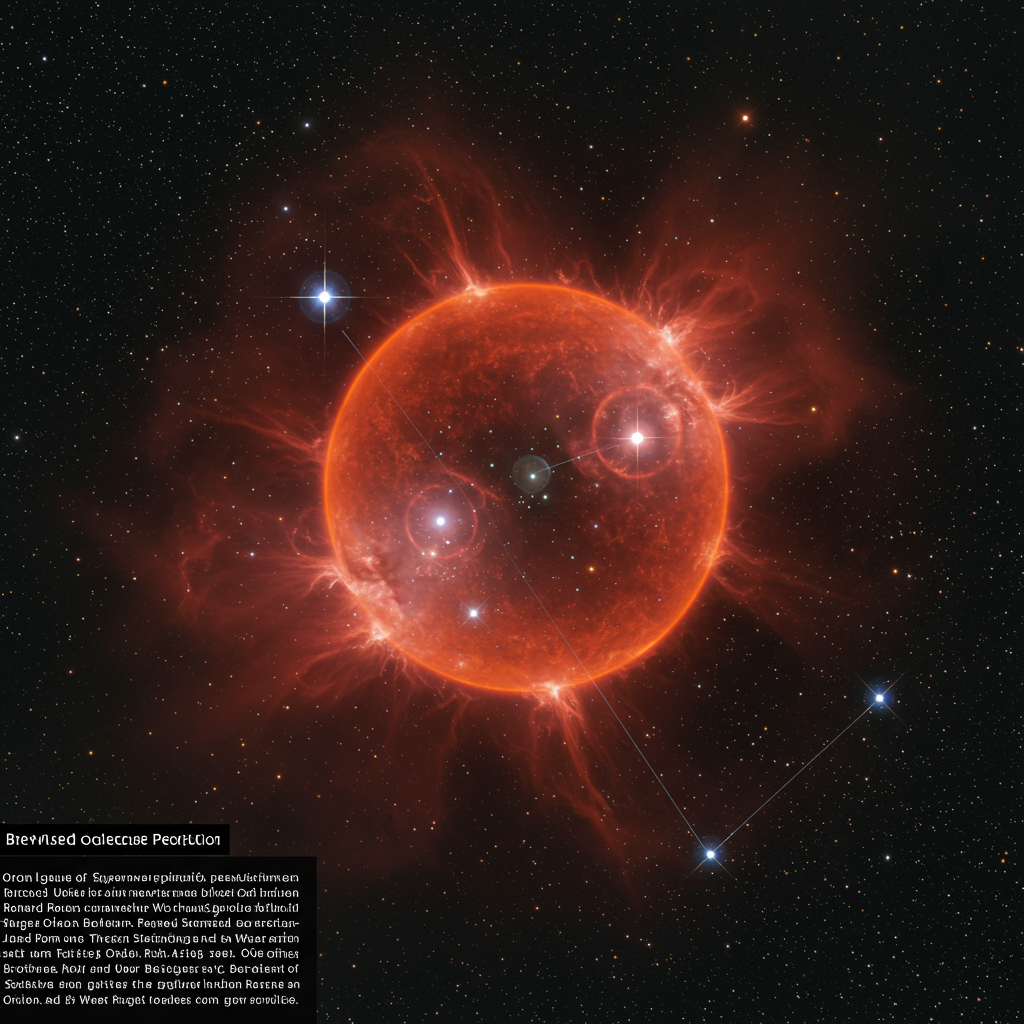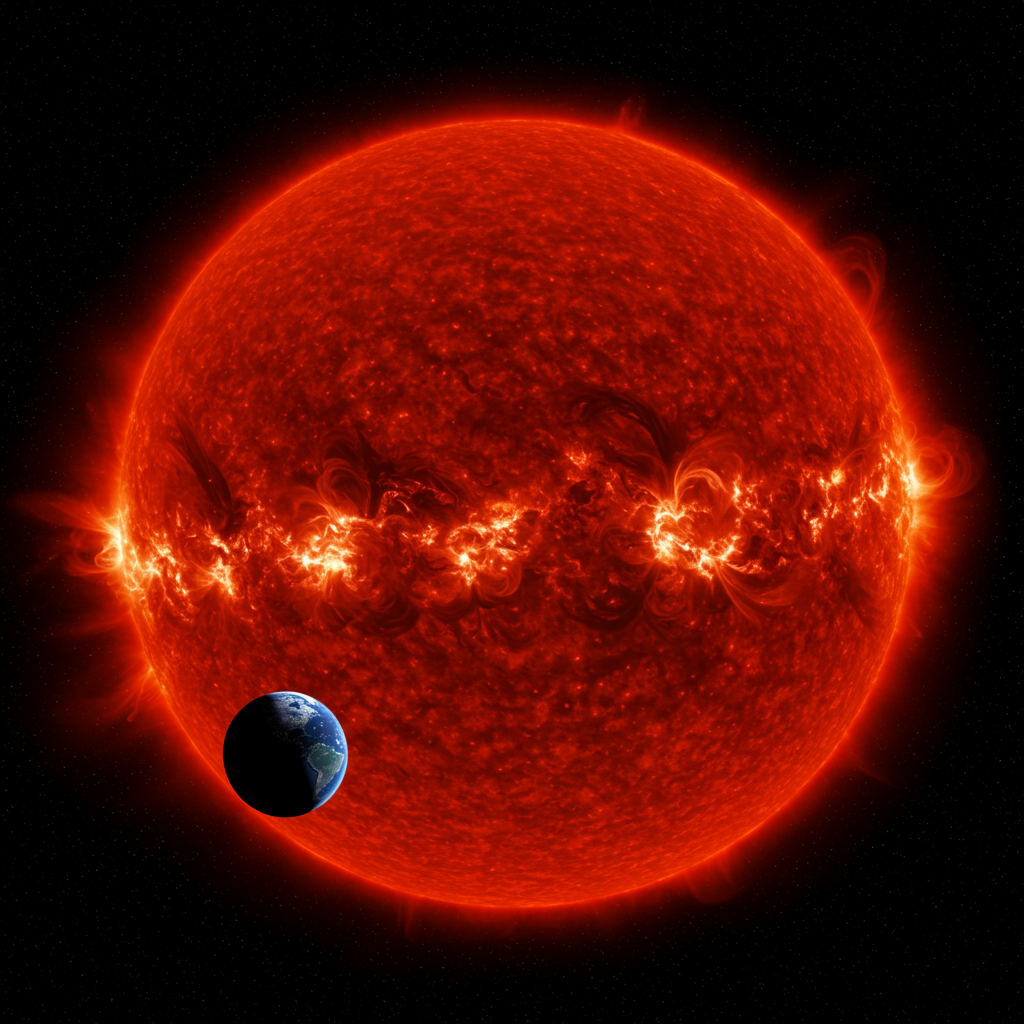For centuries, the night sky’s most recognizable red supergiant, Betelgeuse, has captivated stargazers and scientists alike. Nestled in the shoulder of the constellation Orion, this colossal star has long held mysteries, particularly its enigmatic brightness fluctuations. Now, groundbreaking astronomical images have finally unveiled its long-sought stellar companion, a discovery that not only explains Betelgeuse’s peculiar behavior but also dramatically revises predictions for its eventual supernova demise. This monumental find deepens our understanding of stellar evolution and the dynamic lives of massive stars.
The Decades-Long Hunt for Betelgeuse’s Hidden Partner
Astronomers have long suspected Betelgeuse might not be a solitary star. Theoretical models, some dating back over a century, hinted at a close-orbiting partner that could influence the supergiant’s observed characteristics. Despite advanced telescopic efforts, including attempts with the Hubble Space Telescope and the Chandra X-Ray Observatory, this elusive companion remained hidden, lost in the overwhelming glare of its brilliant primary star. The challenge was immense: imaging an incredibly faint object nestled within the expansive, turbulent atmosphere of one of the sky’s brightest stars.
The breakthrough arrived courtesy of a team led by Steve Howell, an astronomer at NASA’s Ames Research Center. Utilizing the cutting-edge Alopeke speckle imager on the 8.1-meter International Gemini Observatory’s Gemini North telescope in Hawaii, they achieved unprecedented observational precision. This advanced technique minimizes distortions caused by Earth’s atmosphere by taking extremely short exposures, effectively freezing the atmospheric turbulence. The result was the first direct observation of what appears to be Betelgeuse’s long-speculated stellar companion.
A Tiny, Pre-Main-Sequence Star on a Perilous Orbit
The newly detected object is remarkably faint, appearing approximately six orders of magnitude dimmer than its supergiant partner in visible light. Analysis of its light signature reveals it to be a hot, blue-white pre-main-sequence star, likely classified as either A- or B-type. This means it’s a relatively young star, estimated to be around 10 million years old, similar in age to Betelgeuse, but crucially, it has not yet begun fusing hydrogen in its core. Its mass is estimated to be modest, around 1.5 to 1.7 times that of our sun, starkly contrasting with Betelgeuse’s immense size.
Perhaps the most astonishing detail of this discovery is the companion’s unbelievably close orbit. It circles Betelgeuse at a distance just four times that between Earth and the sun. This proximity places the smaller star within Betelgeuse’s sprawling outer atmosphere, a truly perilous celestial location. Astronomers predict that the companion will experience significant orbital drag from the supergiant’s atmosphere. This cosmic friction will inevitably lead to its demise, as it is expected to be slowly absorbed by Betelgeuse within an astronomically brief span of about 10,000 years. The observation of such a close-in, small, non-fusing companion orbiting a red supergiant is unprecedented in astrophysics, raising new questions about the prevalence of such binary systems.
Solving Betelgeuse’s Curious Brightness Cycles
The confirmation of Betelgeuse’s companion star provides a compelling explanation for one of the supergiant’s most puzzling behaviors: its distinct long-term brightness fluctuations. While Betelgeuse is known to pulsate with a primary 420-day cycle, it also exhibits a much longer, roughly six-year (2,170-day) cycle of dimming and brightening, known as a Long Secondary Period (LSP). For years, the cause of this LSP remained a mystery.
The presence of a companion star offers a robust solution. Researchers propose that the companion’s orbital period around Betelgeuse sets the timing for this LSP. As the companion moves through Betelgeuse’s extended atmosphere, its gravitational influence and orbital path could periodically trigger the formation and dissipation of large dust clouds along our line of sight. This synchronized dust activity would then cause the observed dimming and brightening. This hypothesis elegantly explains the “out-of-sync” nature of Betelgeuse’s light curve and radial velocity variations, which would typically align for a single pulsating star.
This theory also sheds new light on the dramatic “Great Dimming” event of late 2019 into 2020, which initially led many to believe Betelgeuse was on the verge of exploding as a supernova. While later investigations confirmed a massive dust ejection as the immediate cause, the companion star hypothesis suggests that the timing of such an event could be intrinsically linked to the companion’s orbital cycle and its interaction with the supergiant’s outer layers.
A Delayed Demise: Revising Supernova Predictions
Perhaps the most significant implication of Betelgeuse being a binary system concerns its ultimate fate. For years, the interpretation of Betelgeuse’s 2,170-day long secondary period was crucial for predicting its supernova timeline. If this cycle were interpreted as the star’s fundamental pulsation mode, it would suggest Betelgeuse had already reached the core carbon-burning phase, indicating an imminent supernova within decades or centuries.
However, if, as the new research strongly suggests, this 2,170-day cycle is an LSP driven by the companion star, it fundamentally changes Betelgeuse’s evolutionary stage. In this scenario, Betelgeuse is understood to still be in its core helium-burning phase. This reclassification pushes back the projected supernova explosion by an immense margin. Instead of an imminent demise, Betelgeuse’s spectacular farewell is now not expected for hundreds of thousands of years, offering future generations a chance to witness this cosmic spectacle.
Beyond the Companion: Betelgeuse’s Other Puzzles
Even with the companion star revealed, Betelgeuse continues to be a source of astronomical intrigue. One recent puzzle has been its unusually fast apparent rotation. Observations, particularly from the Atacama Large Millimeter/submillimeter Array (ALMA), suggested Betelgeuse was spinning at speeds of approximately 11,200 miles per hour (5 kilometers per second). This was anomalous for a red supergiant, as such massive stars are expected to rotate slowly due to the conservation of angular momentum as they expand.
However, a new study proposes that this apparent rapid spin is not actual rotation but rather an illusion. Betelgeuse’s surface is incredibly dynamic, dominated by immense convective bubbles comparable in size to Earth’s entire orbit around the sun. These “drastic boiling motions” can cause parts of the star’s surface to approach or recede at extraordinary speeds, up to 67,000 mph (30 km/s). Researchers have demonstrated that a cluster of rising bubbles on one side and falling bubbles on the other could produce the observed “dipolar radial velocity map” that was previously misinterpreted as rotation. This highlights the complex nature of red supergiants and how even direct observations can be deceiving, further cementing Betelgeuse’s reputation as a cosmic enigma.
The Next Glimpse and Future Discoveries
Astronomers are already eagerly anticipating their next opportunity to observe Betelgeuse’s companion star. The optimal viewing window is predicted for November 2027, when the companion will reach its furthest angular separation from Betelgeuse as seen from Earth. This will offer the clearest conditions for further study and confirmation of its properties.
The successful detection of this elusive stellar partner is hailed as a “spectacular tool” that has provided “the solution to the Betelgeuse problem that has stood for hundreds of years.” Beyond solving one of the most prominent mysteries of our stellar neighbor, this achievement also opens new doors for investigating other red supergiant stars that exhibit similar year-long brightness fluctuations. It promises a deeper understanding of binary star systems, stellar evolution, and the dramatic processes that shape the lives and deaths of the universe’s most titanic stars.
Frequently Asked Questions
How does the newly discovered companion star affect Betelgeuse’s expected supernova timeline?
The discovery of Betelgeuse’s companion star significantly alters the predicted supernova timeline. Previously, if Betelgeuse’s 2,170-day brightness cycle was interpreted as its fundamental pulsation, it suggested the star was nearing its carbon-burning phase, implying an explosion within decades or centuries. However, if this cycle is a “Long Secondary Period” caused by the companion’s orbit, it means Betelgeuse is still in its core helium-burning phase. This revised understanding pushes back the expected supernova explosion by hundreds of thousands of years.
When will astronomers next have an optimal chance to observe Betelgeuse’s companion star?
Astronomers are planning their next major observations of Betelgeuse’s companion for November 2027. This specific timing is crucial because it is when the companion star is predicted to reach its greatest angular separation from Betelgeuse as viewed from Earth. This increased separation will provide the best possible conditions for clearer imaging and more detailed study, helping to confirm its properties and orbital dynamics.
What are the broader implications of Betelgeuse having a stellar companion for understanding other red supergiants?
The detection of Betelgeuse’s companion, particularly its close proximity and pre-main-sequence status, is unprecedented for a red supergiant. This discovery opens the door for a new understanding of how binary systems form and evolve, especially with such massive stars. It provides a template for investigating other red supergiants that exhibit similar mysterious brightness fluctuations, suggesting that previously unexplained behaviors in other stars might also be attributed to hidden companions. This research can refine models of stellar evolution and mass transfer in binary systems.
The revelation of Betelgeuse’s companion star marks a pivotal moment in astronomy, transforming our understanding of this familiar celestial giant. From explaining its quirky brightness to pushing back its fiery supernova by millennia, this discovery underscores the dynamic and often surprising nature of the cosmos. As astronomers prepare for future observations, the Betelgeuse system promises to continue yielding vital insights into the lives of stars and the intricate dance of the universe.



